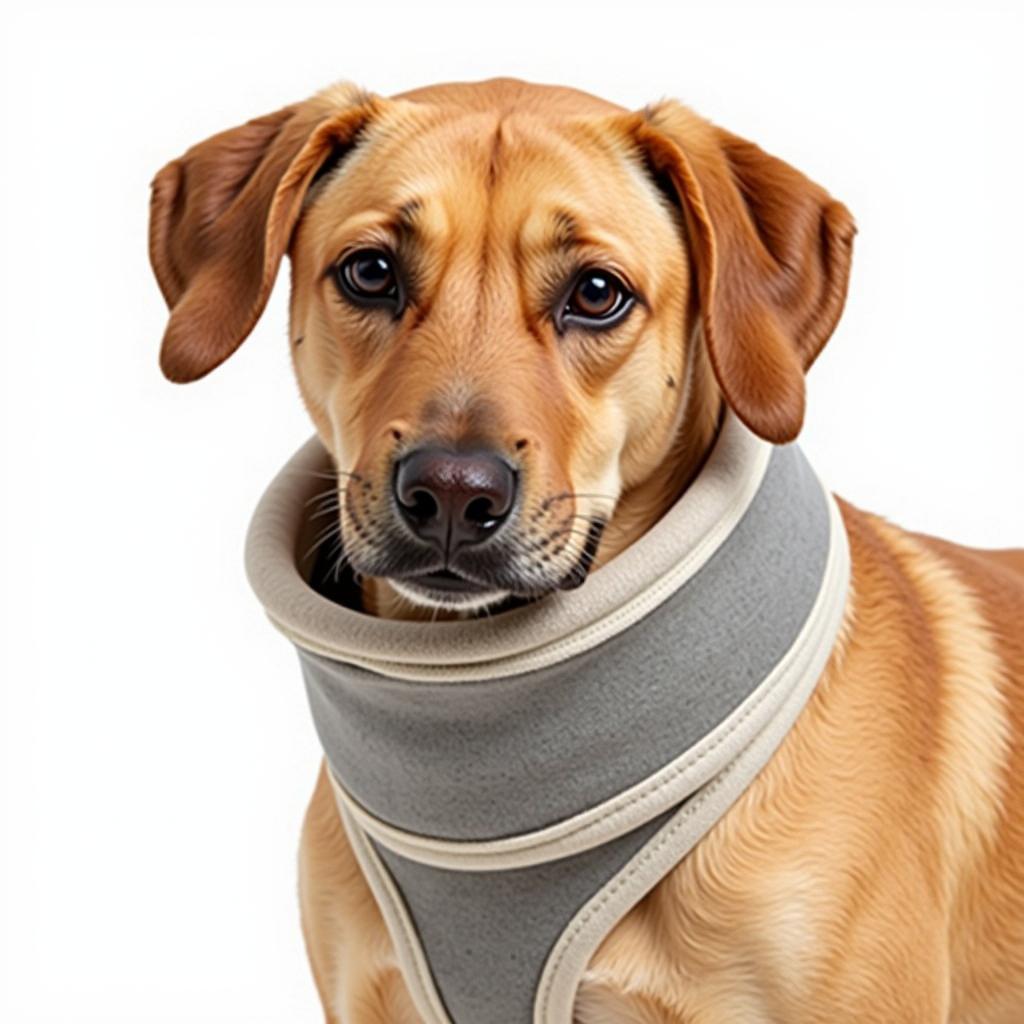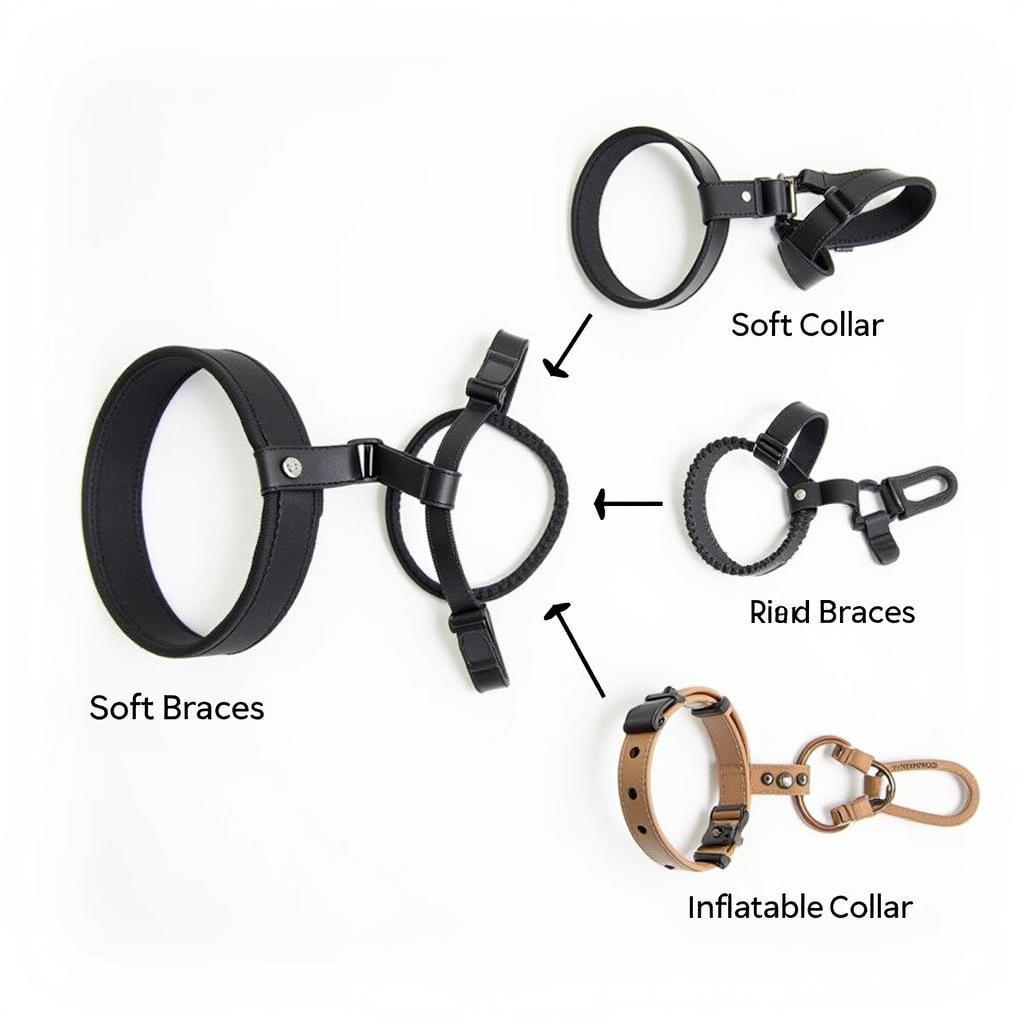Neck braces for dogs, also known as cervical collars, are veterinary devices designed to support and stabilize the neck and spine. They’re used in various situations, from post-surgical recovery to managing chronic conditions. Understanding when and how to use a neck brace for your furry friend is crucial for their well-being.
When Does Your Dog Need a Neck Brace?
Neck braces for dogs serve multiple purposes, including immobilizing the neck after surgery or injury, alleviating pain from conditions like Wobbler syndrome or intervertebral disc disease (IVDD), and preventing further injury. Your veterinarian might recommend a neck brace if your dog exhibits symptoms like neck pain, stiffness, weakness, or difficulty walking.
Common Conditions Requiring a Neck Brace
- Intervertebral Disc Disease (IVDD): This common condition occurs when the cushioning discs between vertebrae degenerate or rupture, causing pain and neurological issues. A neck brace can help stabilize the spine and reduce pressure on the affected discs.
- Wobbler Syndrome: This neurological disorder affects the cervical spine, causing compression of the spinal cord and resulting in a wobbly gait. Neck braces can provide support and stability, improving mobility.
- Post-Surgical Recovery: After neck surgery, a brace is essential for immobilizing the area and promoting proper healing. This helps prevent complications and ensures a smoother recovery.
- Trauma or Injury: In cases of neck trauma, such as whiplash or fractures, a neck brace can stabilize the spine and prevent further damage.
 Dog wearing a neck brace to prevent licking wounds
Dog wearing a neck brace to prevent licking wounds
Choosing the Right Neck Brace for Dogs
Selecting the appropriate neck brace is critical for your dog’s comfort and recovery. There are various types available, including soft collars, rigid braces, and inflatable collars. Consult with your veterinarian to determine the best type and size for your dog’s specific needs. They’ll consider factors such as the underlying condition, the size and breed of your dog, and the desired level of immobilization.
Types of Neck Braces
- Soft Collars: These are typically made of foam or fabric and provide mild support. They’re suitable for post-surgical recovery or minor injuries.
- Rigid Braces: Made from hard plastic or metal, these braces offer greater stability and are often used for more severe injuries or conditions.
- Inflatable Collars: These collars provide a comfortable alternative to traditional cones and can also offer some neck support.
Measuring Your Dog for a Neck Brace
Accurate measurement is crucial for a proper fit. Measure the circumference of your dog’s neck, starting at the base of the skull and wrapping the measuring tape around the thickest part of the neck. Refer to the manufacturer’s sizing chart for the specific brace you are considering.
Caring for Your Dog in a Neck Brace
While wearing a neck brace, your dog will require extra care and attention. Monitor the brace regularly for signs of wear and tear and ensure it fits properly. Keep the area around the brace clean and dry to prevent skin irritation.
Tips for Managing a Dog with a Neck Brace
- Supervise your dog closely: Prevent them from chewing or scratching at the brace.
- Limit activity: Restrict strenuous exercise and jumping while your dog is wearing the brace.
- Provide a comfortable resting area: Ensure your dog has a soft and supportive place to rest.
Frequently Asked Questions (FAQ)
- How long will my dog need to wear a neck brace?
- Can my dog sleep in a neck brace?
- How do I clean my dog’s neck brace?
- What are the signs that the neck brace doesn’t fit properly?
- Are there any alternatives to a Neck Brace For Dogs?
- Can a neck brace completely cure my dog’s condition?
- How do I know if my dog is experiencing discomfort with the brace?
Conclusion
Neck braces for dogs can be an invaluable tool in managing a variety of neck and spine conditions. By understanding the different types of braces available, choosing the right one for your dog, and providing proper care, you can help ensure a comfortable and successful recovery. Remember to consult with your veterinarian for personalized advice and guidance on using a neck brace for your furry companion.
 Different types of neck braces for dogs
Different types of neck braces for dogs
Khi cần hỗ trợ hãy liên hệ Số Điện Thoại: 0909802228, Email: doibongda@gmail.com Hoặc đến địa chỉ: 101 Đ. Lý Chiêu Hoàng, Phường 10, Quận 6, Hồ Chí Minh, Việt Nam. Chúng tôi có đội ngũ chăm sóc khách hàng 24/7.